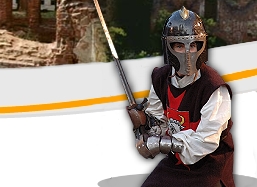|
Ragnit Castle in Nieman (Nieman District)
On 23rd April 1289 the Landmeister (provincial Master) of
the Teutonic Order in Prussia, Meinhard von Querfurt, attacked
the lands of the Skalvians. Afterwards he ordered to construct
a Teutonic fortress which was to replace an old Prussian fort
called 'Ragaine'. The new stronghold was named 'Landehut',
meaning 'the land's guarding fort' or 'the land's defence'.
At the turn of the 13th and 14th centuries, the Teutonic
Knights were involved in exhausting battles with Lithuania
over Skalovia. At that time the former name of the fort, 'Ragnit',
was revived. Ragnit Castle became the most part of the defence
system built by the Teutonic Knights in the borderland between
Prussia and Lithuania, and also one of the major links in
a chain of fortresses protecting the Monastic State of the
Order.
Despite being a powerful stronghold, Ragnit Castle sometimes
fell into the hands of enemy. In 1397-1409 the Teutonic Knights
built a new brick and stone castle in Ragneta. The works were
supervised by the Master of the Teutonic Order, Konrad Fellenstein
of Marienburg.
A huge stone and brick fortress was raised, surrounded with
a moat and an embankment, which formed an enclosed square.
The size of the inner ward was about 1.000 square meters.
The main entrance, decorated with a granite doorframe, was
located in the west wing. The entrance could be closed securely
with an iron grate. Some time later a watchtower, about 25
meters high, was raised near the castle.
In November 1678 Ragenta Castle was seized by the Swedish
troops, who stayed in the castle for about a year until Grand
Master Frederic Wilhelm arrived with reinforcements and forced
the occupants to leave the castle. Once the Swedish troops
had withdrawn, the castle underwent necessary repairs.
In 1722 the village of Ragnit was granted a town charter.
The historic coats of arm of the town looked as follows: a
silhouette of the fortified town - silvery townhouses with
red roofs - featured on a blue background. Above the town,
within in a glistening gold triangle God's Eye was set, as
if watching and giving its grace to the town's citizens. And
nearby there was an eagle - a powerful and free birds. Below
the town, quiet waters of the Neman River were flowing.
During the Napoleonic wars, French troops stationed in the
castle. In December 1812 Russians entered the town, lead by
General Alexander Kutuzov, a relative of an outstanding Russian
army commander, Michail Illarionovich Kutuzov.
In the 1930s, the historic fortress of Ragnit lost its defensive
character. The castle was reconstructed to function as a seat
of a law court and a prison.
Today we can admire the ruins of the castle, including its
watchtower, which still stand in the centre of the town, on
the Neman River. Unfortunately, the devastation and unsanitary
appearance of what has been left of the fortress are a sad
reminder of our indifferent attitude to the past. A few years
ago, when some filmmakers were looking for a location to shoot
war scenes, the ruined fortress was rediscovered. Some effort
was even made to preserve the ruins. All in vain, God's Eye
has turned away from the town's dwellers and does not watch
over the castle or the town. So it is the residents of Ragnit
who should assume the responsibility for their historic heritage.
|






![]()
![]() On
the trail of the castles in the Baltic Sea region - revitalization and promotion
of the objects
On
the trail of the castles in the Baltic Sea region - revitalization and promotion
of the objects